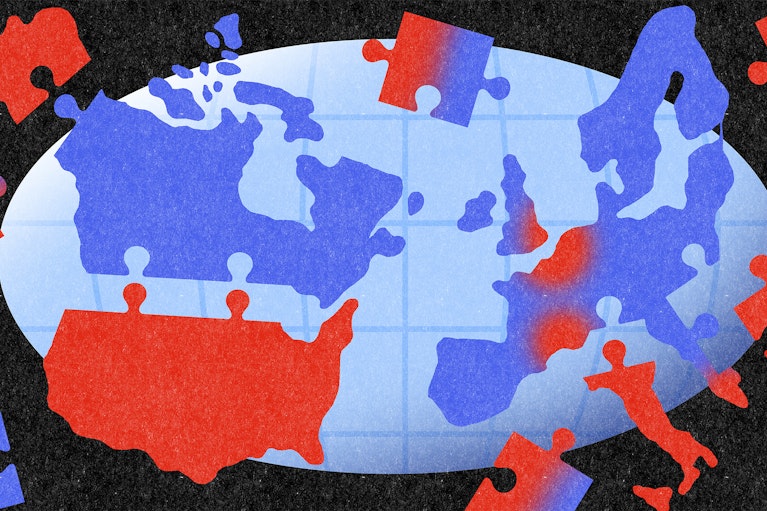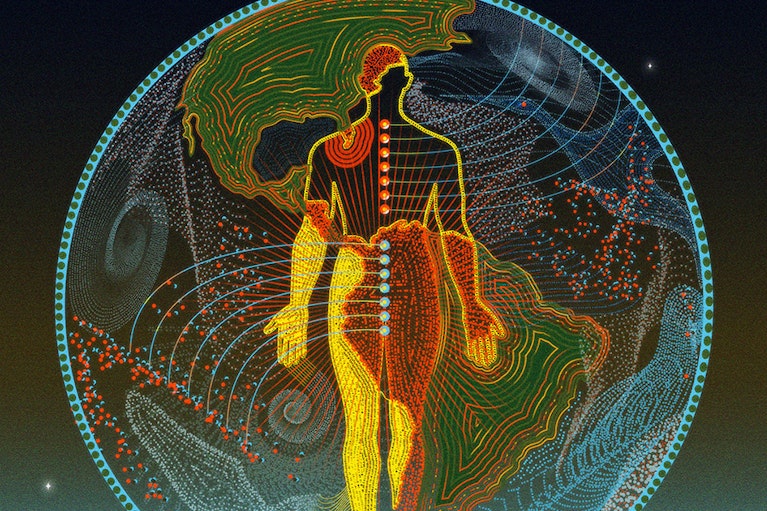Last July, Anthony Bourdain’s voice was resurrected from the dead. In “Roadrunner,” a film chronicling his life, he can be heard reading from a letter he wrote to a friend: “My life is sort of shit now,” he says. “You are successful, and I am successful, and I’m wondering: Are you happy?”
That pained quote, though, was generated by an AI model of Bourdain’s voice. The director of the film, Morgan Neville, commissioned the soundbite from a company that produces vocal deepfakes from sonic archives. Neville defended this creative choice, but the public mostly decried it as a creepy blasphemy of Bourdain’s memory.
Reproduction technologies have been used to conjure dead celebrities before: Tupac Shakur’s hologram performing at Coachella, a CGI Fred Astaire in a Dirt Devil vacuum cleaner commercial, Peter Cushing in “Star Wars: Rogue One.” But with deepfakes — which use machine learning to synthesize lifelike facsimiles of human voices, images or videos — we have entered uncanny new terrain. Vocal deepfakes are particularly fraught due to the unique status of the voice, which has long been understood as a vessel for the human soul. For this reason, the history of sound recording and reproduction is rife with fantasies of technological necromancy.
But vocal deepfakes don’t have to be ghost stories. With boundaries, they can be used by artists to achieve something like creative immortality.
Technology And Necromancy
The advent of sound recording in the 19th century created new possibilities for preserving the dead. As Thomas Edison was perfecting the technologies that would become the phonograph, he celebrated the instrument’s capacity to preserve “the sayings, the voices and the last words of the dying member of the family — as of great men.”
This vision was an articulation of both the singularity of the human voice and a moment of its profound transformation. A person’s vocal signature is a complex and idiosyncratic cocktail of biology, physiology, habits and culture. Sound recording severed voice from body and gave it a new and separate existence.
The core beliefs animating early sound media suggest a deeper impulse than mere preservation. Well into the 20th century, nearly every new communication technology was harnessed in service of cultural fantasies of transmitting disembodied voices from the great beyond. During Spiritualist seances, mediums employed knocking sounds echoing the then-new telegraph machine. Self-proclaimed “phone-voyants” touted their unique abilities to reach the departed by telephone. And in 1920, The American Magazine published an interview with Edison where he discussed his work “building an apparatus to see if it is possible for personalities which have left this Earth to communicate with us.”
All these efforts attest to the longstanding entwinement of science and the supernatural — and of the belief that telecommunication technologies might serve as channels into the afterlife.
“Sound recording severed voice from body and gave it a new and separate existence.”
Digital technologies offered new spaces for these occult imaginations. From the invention of the telegraph to the later introduction of television and computers, electronic media have persistently been associated with otherworldly phenomena. The radio play “War of the Worlds” and the TV series “The Twilight Zone,” among many other popular stories, expressed a cultural fascination with how new communication technologies warped time and space. This mythology continues to haunt cultural thinking about cyberspace, virtual reality and the internet.
The media historian Jeffrey Sconce has traced how such cultural narratives have evolved over time into a broader unease about the dominance of digital technologies over our lives. These cultural fictions have a force far beyond the popular imagination — and continue to shape how technologies are built and deployed.
Recent developments in artificial intelligence offer new ways to reach the ghosts in the machine. Replika, for example, is a chatbot run by a neural network trained on text conversations to create a digital doppelganger that could, in theory, become a living memorial for those left behind.
From Necromancy to Necrophilia
While communication technologies of all kinds are haunted by apparitions of the dead, sound media uniquely bear something of a life essence. Emanating from the interior of the human body, the voice signifies something ineffable about a person’s identity, even their soul. Recorded music enfolds these features of the voice into an artistic vision and style, packaging it as an object of individual expression and intellectual property. For this reason, the use — and misuse — of sonic artifacts have been especially charged, sustaining intense criticism and heady celebration.
Hip-hop DJs stirred controversy by willfully using records as they were never intended to create sample-based music. By mixing records on turntables and in studios, DJs and producers placed musical fragments into new contexts, at times profoundly changing their original meaning. James Mtume, a jazz musician who played with Miles Davis, condemned this practice as “artistic necrophilia,” casting it as a transgression of the sacrosanct border between life and death.
“Used to reanimate the dead, vocal deepfakes raise pressing ethical questions about the agency of the deceased.”
The musician Holly Herndon, who uses AI as a compositional tool, has invoked artistic necrophilia to describe contemporary uses of artificial intelligence in vocal deepfakes and generative music. Herndon does not denounce AI wholesale and treats machine learning as a creative medium, pressing it to perform in new and imaginative ways. She draws a distinction between her approach and projects like OpenAI’s Jukebox, a neural net trained on datasets spanning music from almost every genre, which pirates original artists by generating songs and lyrics in the style of celebrities both living and dead.
By ventriloquizing dead performers with synthetic vocal models, AI consummates sound media’s abiding desire for resurrection. Used to reanimate the dead, vocal deepfakes raise pressing ethical questions about the agency of the deceased. Much of the public controversy around Bourdain’s vocal clone arose from a sense that the man himself wouldn’t appreciate a crass reincarnation. Bourdain’s public image, as Helen Rosner noted in The New Yorker, is grounded in his commitment to authenticity. In “Roadrunner,” Neville doesn’t tell the audience that Bourdain didn’t actually speak those words, which some see as a failure to honor his memory.
Deepfaking The Creative Hereafter
As artificial intelligence reshapes our creative landscapes, artists have an opportunity to define whether the ghost in the deepfake machine is genuinely theirs or some database zombie. Though the legal terrain remains complex, they could look proactively beyond their own deaths and collaborate with AI from beyond the veil.
AI is us; it is human labor concealed. Choices about how to curate and label the creative data used to train deep learning algorithms are just as central to an artistic legacy as the archive itself. Futurecasting beyond their deaths, an artist could reflect on the affordances of creative data and excavate a kernel of their own artistic identity. This artistic core might reflect the entire landscape of their personal archive, mere fragments or nothing at all.
By defining their estate plans to reckon with the more ephemeral qualities of their vocal identities, artistic styles and the possibility of new creative contexts generated by artificial intelligence, artists could fashion a future from beyond the grave. Such a plan would set the terms for posthumous creativity by delimiting how, why, where and by whom a musical archive is used as training data.
One approach would be to defy the logic of big data. According to researcher Kate Crawford, AI systems and the industry that creates them are motivated by a ruthless logic that “everything is data and is there for the taking.” By this logic, discrete objects — whether mugshot or soundbite — are stripped of personal, social and political meaning and harvested as raw data in service of profit.
“Artists and their heirs can mitigate the transformation of their voices into pure commodities and infuse their hereafters with creative intention.”
So determined, an AI resurrection can corrode a person’s living memory with the demands of capital and infrastructure. In imagining their creative afterlife, an artist might approach their sonic archive selectively. Rather than allowing all their data to be fodder for creating vocal models, they might allow only specific parts of their oeuvre that represent eras, themes or concepts in their artistic trajectory. A vocal model might then reflect a tightly choreographed slice of an artist’s life.
An artist might also restrict or envision new potential contexts for their resurrections, whether in relation to genre or purpose. They could define the contexts of deployment — commercial uses or giving voice to views against their beliefs might be out of the question. Like Bourdain’s digital doppelganger, they might even rebuke attempts to ventriloquize their own words. Legal frameworks in intellectual property and copyright law have worked to keep pace with new technologies, and not all jurisdictions recognize postmortem rights of publicity. Even so, by planning ahead, artists and their heirs can mitigate the transformation of their voices into pure commodities and infuse their hereafters with creative intention.
Technologies, like the humans who create them, will continue to spawn as-yet-unimagined creative possibilities. However thoroughly an artist prepares for that future, these parameters will be tested in the ever-expanding capacity of technologies, AI or otherwise, to foster new creative and commercial contexts.
Media history is a library of ghost stories. But rather than having their voices and memories manipulated to conjure pale apparitions of the past, artists can use AI as a creative tool for a living future.






